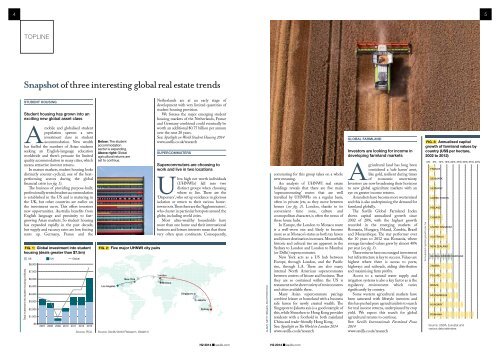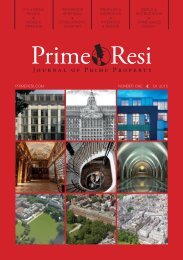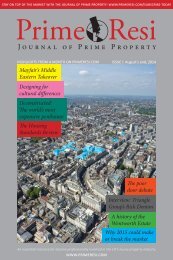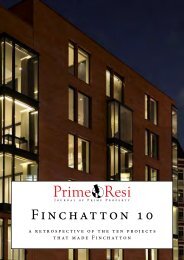Savills 12 Cities Report
Live/Work Index
Live/Work Index
Create successful ePaper yourself
Turn your PDF publications into a flip-book with our unique Google optimized e-Paper software.
4 5<br />
topline<br />
Snapshot of three interesting global real estate trends<br />
student housing<br />
Student housing has grown into an<br />
exciting new global asset class<br />
Amobile and globalised student<br />
population spawns a new<br />
investment class in student<br />
accommodation. New wealth<br />
has fuelled the numbers of Asian students<br />
seeking an English-language education<br />
worldwide and there’s pressure for limited<br />
quality accommodation in many cities, which<br />
means attractive investor returns.<br />
In mature markets, student housing looks<br />
distinctly counter-cyclical; one of the bestperforming<br />
sectors during the global<br />
financial crisis (see fig. 1).<br />
The business of providing purpose-built,<br />
professionally rented student accommodation<br />
is established in the US and is maturing in<br />
the UK, but other countries are earlier on<br />
the investment curve. This offers investors<br />
new opportunities. Australia benefits from<br />
English language and proximity to fastgrowing<br />
Asian markets. So student housing<br />
has expanded rapidly in the past decade,<br />
but supply and vacancy rates are low, forcing<br />
rents up. Germany, France and the<br />
Fig. 1: Global investment into student<br />
housing (deals greater than $7.5m)<br />
Total investment into student housing (millions)<br />
US<br />
$8,000<br />
$7,000<br />
$6,000<br />
$5,000<br />
$4,000<br />
$3,000<br />
$2,000<br />
$1,000<br />
$0<br />
UK<br />
Global<br />
2007 2008 2009 2010 2011 2013 2013<br />
Source: RCA<br />
Below: The student<br />
accommodation<br />
sector is expanding.<br />
Above right: Global<br />
agricultural returns are<br />
set to continue.<br />
Fig. 2: Five major UHNWI city pairs<br />
Los Angeles<br />
New York<br />
Source: <strong>Savills</strong> World Research, Wealth X<br />
Netherlands are at an early stage of<br />
development with very limited quantities of<br />
student housing provision.<br />
We foresee the major emerging student<br />
housing markets of the Netherlands, France<br />
and Germany combined could eventually be<br />
worth an additional $0.75 billion per annum<br />
over the next 20 years.<br />
See: Spotlight on World Student Housing 2014<br />
www.savills.co.uk/research<br />
supercommuters<br />
Supercommuters are choosing to<br />
work and live in two locations<br />
Ultra high net worth individuals<br />
(UHNWIs) fall into two<br />
distinct groups when choosing<br />
where to live. There are the<br />
‘Dispersers’, who set up residence in glorious<br />
isolation or return to their various hometown<br />
roots. Then there are the ‘Agglomerators’,<br />
who cluster in particular hotspots around the<br />
globe, including world cities.<br />
Most ultra-wealthy households have<br />
more than one home and their international<br />
business and leisure interests mean that these<br />
very often span continents. Consequently,<br />
London<br />
Monaco<br />
Singapore<br />
Jakarta<br />
Sydney<br />
Alamy, Getty Images, Shutterstock<br />
commuting for this group takes on a whole<br />
new meaning.<br />
An analysis of UHNWI real estate<br />
holdings reveals that there are five main<br />
‘supercommuting’ routes that are well<br />
travelled by UHNWIs on a regular basis,<br />
often in private jets, as they move between<br />
homes (see fig. 2). London, thanks to its<br />
convenient time zone, culture and<br />
cosmopolitan character, is often the nexus of<br />
these home hubs.<br />
In Europe, the London to Monaco route<br />
is a well-worn one and likely to become<br />
more so as Monaco’s status as both tax haven<br />
and leisure destination increases. Meanwhile,<br />
historic and cultural ties are apparent in the<br />
Sydney to London and London to Mumbai<br />
(or Delhi) supercommutes.<br />
New York acts as a US hub between<br />
Europe, through London, and the Pacific<br />
rim, through LA. There are also many<br />
internal North American supercommutes<br />
between centres of leisure and business. That<br />
they are so contained within the US is<br />
testament to the sheer variety of environments<br />
and cities available there.<br />
Many Asian supercommute pairings<br />
combine leisure or homeland with a business<br />
safe haven for newly created wealth. The<br />
Singapore to Jakarta axis is a good example of<br />
this, while Shenzhen to Hong Kong provides<br />
residents with a foothold in both mainland<br />
China and trade-friendly Hong Kong.<br />
See: Spotlight on The World in London 2014<br />
www.savills.co.uk/research<br />
Global farmland<br />
Investors are looking for income in<br />
developing farmland markets<br />
Agricultural land has long been<br />
considered a ‘safe haven’ asset,<br />
like gold, resilient during times<br />
of economic uncertainty.<br />
Investors are now broadening their horizons<br />
to new global agriculture markets with an<br />
eye on greater income returns.<br />
Asian diets have become more westernised<br />
and this is also underpinning the demand for<br />
farmland globally.<br />
The <strong>Savills</strong> Global Farmland Index<br />
shows capital annualised growth since<br />
2002 of 20%, with the highest growth<br />
recorded in the emerging markets of<br />
Romania, Hungary, Poland, Zambia, Brazil<br />
and Mozambique. The star performer over<br />
the 10 years to 20<strong>12</strong> was Romania, where<br />
average farmland values grew by almost 40%<br />
per year (see fig. 3).<br />
These returns have encouraged investment<br />
but infrastructure is key to success. Values are<br />
highest where there is access to ports,<br />
highways and railroads, aiding distribution<br />
and maximising farm profits.<br />
Access to a natural water supply and<br />
irrigation systems is also a key factor as is the<br />
regulatory environment which varies<br />
significantly by country.<br />
Some western agricultural markets have<br />
been saturated with lifestyle investors and<br />
this has pushed pure agriculturalists to search<br />
for real income returns, underpinned by crop<br />
yield. We expect this search for global<br />
agricultural returns to continue.<br />
See: <strong>Savills</strong> Internationals Farmland Focus<br />
2014<br />
www.savills.co.uk/research<br />
Fig. 3: Annualised capital<br />
growth of farmland values by<br />
country (US$ per hectare,<br />
2002 to 20<strong>12</strong>)<br />
Annualised capital growth per ha<br />
0% 5% 10% 15% 20% 25% 30% 35% 40%<br />
FRANCE<br />
DENMARK<br />
GERMANY<br />
UNITED STATES<br />
IRELAND<br />
CANADA<br />
UNITED KINGDOM<br />
AUSTRALIA<br />
NEW ZEALAND<br />
GLOBAL INDEXED AVERAGE<br />
ZAMBIA<br />
POLAND<br />
BRAZIL<br />
MOZAMBIQUE<br />
HUNGARY<br />
ROMANIA<br />
Source: USDA, Eurostat and<br />
various data estimates<br />
H2 2014<br />
savills.com<br />
H2 2014<br />
savills.com







